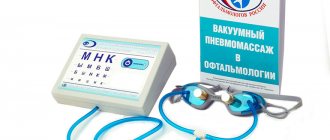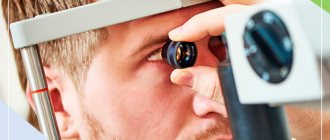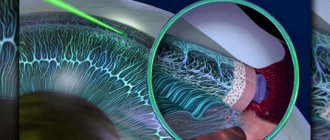Is it possible to get disability with glaucoma?
The study of the problem of social adaptation and preservation of working capacity of people with low vision, completely lost vision and people with disabilities due to diseases of these organs is dealt with by a separate direction in ophthalmology - clinical and social ophthalmology.
It is specialists in this field who conduct medical and social examinations; their competence includes the assignment of disability due to pathology of the visual organs. At the moment, disabled people include those people who have persistent disorders of the functions of organs and systems that occurred as a result of diseases, injuries, defects and led to limitation of life activity. Disabled people who are unable to care for themselves, who are forced to seek someone’s help for movement, orientation in space, communication, as well as those who cannot engage in labor activity, are disabled. Before reaching adulthood, an individual with disabilities is classified as a disabled child; after this age, he is defined as a disabled person.
During a medical and social examination, a large number of important issues for the person applying are resolved. In particular, the types and terms of rehabilitation are determined, the true cause of pathology in the organs of vision is clarified, and the degree of limitation of life activity is determined. During the examination, the condition of the visual organs, the degree of decrease in visual acuity are checked, and the issue of types of restrictions on work activity is decided. Based on the results of the commission, a verdict is made on the degree of disability, the reasons for its occurrence, the timing and limitation of working capacity, as well as what benefits a disabled person can claim. In addition, a rehabilitation program is being developed on a recommendatory basis.
Is there a disability status if one eye cannot see?
- Restrictions of the first degree. A person can independently perform familiar actions, but it takes quite a lot of time, or additional aids are used to perform actions.
- Restrictions of the second degree. A person requires help from other people, or needs special conditions to perform actions. Health problems are quite pronounced and persistent.
- Restrictions of the third degree. A person completely loses the ability to function normally and constantly needs help from people around him.
- Examination by an ophthalmologist. The doctor issues a conclusion on the need to assign a disability group to the patient.
- Additional examinations and studies (ECG, ultrasound, etc.).
- The conclusions from all examinations are transferred to the attending physician, who must register the patient for a medical and social examination.
- The patient undergoes a medical and social examination, after which he is assigned a certain disability group and a rehabilitation program is developed.
What grounds allow a person to be assigned one or another degree of disability?
A person is recognized as disabled if he has more than two characteristics:
- A persistent disorder in the functioning of organs and systems that occurs as a result of diseases, injuries, congenital or acquired defects.
- Complete or partial limitation in self-care, orientation, movement, training and inability to carry out work activities in full.
- The need for rehabilitation measures.
The first disability group is assigned for several years, and the second and third - only for a year. In the future, it is necessary to undergo re-examination and confirm the group. There are a number of diseases and conditions in which disability is given for an indefinite period.
Disability due to eye disease
Decreased vision and other types of visual impairments fall into the category of basic body functions. Therefore, persons who have complete or partial loss of vision in one or both eyes may qualify for the disability group.
Currently, there is a tendency not to provide disability for loss of vision in one eye. As long as the healthy eye fully copes with the load placed on it and has normal visual acuity, disability is not assigned. It is believed that a person is able to work, and therefore he has no restrictions on his ability to work. But if there is serious damage to one of the eyes and decreased vision in the second eye, the issue of disability will most likely be resolved positively.
If the difference between the eye that sees better and the eye that sees less is 0.3 or less, a disability is assigned unambiguously.
The third group implies visual acuity of a healthy eye from 0.1 to 0.3. The second group is assigned when the visual acuity of the healthier eye is from 0.1 to 0.05, while the first group of eyes sees only 0.04, down to 0.
Visual acuity is always determined with correction!
It is worth saying that the degree of impairment of the visual analyzer is verified according to the international classifier ICD 10 revision. It fully provides definitions by which the size of the impaired function is determined - visual acuity, visual fields, main indicators of electrophysiological measurements, performance of the sensory apparatus. These indicators can be comprehensively assessed to determine the degree of restriction of the organ’s work. There are three degrees of restriction in total.
What to do in case of refusal
If denied, the person can file an appeal to have the case re-examined. Russian legislation sets forth standards according to which a person who has lost one of the paired organs does not have the right to receive social benefits. This is due to the fact that the remaining second organ can replace the function of the lost one.
We recommend reading: Registration of visual disability in 2019
In a person deprived of one eye, binocular and lateral vision is impaired. If he applies for disability and is not granted it, the committee may decide to limit the patient's activities. In this case, he may lose work, which is not permitted due to his visual impairment. The person will not only not receive benefits, but will also lose his existing job.
If vision is lost in one eye and preserved in the other, it is necessary to change work if it is incompatible with the patient’s current condition. With a certain type of activity, he can harm himself and the people around him.
As a result, if there is no functionality in one eye and normal vision in the other, disability is not given. But there are certain exceptions that are considered by the medical commission. The acuity and visual fields of the remaining eye are taken into account. If a person does not agree with the result obtained, he can file an appeal. But if the functionality of the second eye is completely preserved, it is impossible to receive any benefits.
Disability due to glaucoma
Glaucoma is an eye disease that ranks among the leading causes of disability. Disability due to glaucoma can occur due to injuries and injuries to the eyes, chemical burns, due to pathology of the iris, lens, cornea, inflammatory and dystrophic processes, endocrine, neurological disorders, concomitant eye diseases, as well as congenital abnormalities of the sensory apparatus.
Regarding glaucoma, recommendations have been developed that relate to the patient’s work activity. In particular, various harmful factors must be excluded in the work process - vibration, ultrasonic waves, air dust levels above acceptable standards, toxic substances that negatively affect nervous tissue and blood vessels. It is prohibited to allow persons with glaucoma to perform labor-intensive work with significant physical exertion, heavy lifting, night work, or work with a forced posture with their head down. Professions that cause neuro-emotional overload, as well as work with sudden changes in temperature, are not recommended.
If the field of vision is reduced, persons with this pathology are prohibited from working as public transport drivers or from working at heights.
In addition, there are restrictions in sports activities - any contact sports, sports exercises with lifting heavy weights, as well as training associated with strong tension in the visual analyzer and prolonged tilting of the head are prohibited.
Determination of the degree of disability in glaucoma
In case of glaucoma, the degree of disability is determined according to the following criteria (according to ICD H40−42):
- the degree is characterized by glaucoma of the initial stage, with the healthier eye seeing by 0.03−1.0, with bilateral glaucoma - 0.5−1.0 with correction by the better seeing eye. At this level there are no restrictions on life activity, there are only restrictions according to the medical advisory commission.
- the degree of disability is assigned when there is a significant deepening of the optic nerve head, narrowing of the visual field from 15 to 45° on the side of the nose, and on other sides by 20°. The decrease in visual acuity is 0.09−0.04 in the better-seeing eye with correction. If glaucoma is unilateral, then the decrease in visual acuity can be 0−0.02 or a concentric narrowing of the visual fields up to 5°. With this degree, the 1st degree of restrictions on orientation, ability to learn and work is assigned, and the 3rd disability group is also assigned.
- degree - narrowing of the visual field to 20°, atrophy of the optic nerve or marginal depression of the optic disc. Vision from the better seeing eye is from 0.04 to 0.08. Central or paracentral scotomas may be present. In this case, the degree of disability and life activity limitation is of the second degree and disability group 2 is assigned.
- the degree of visual impairment is almost complete blindness, in which there is a decrease in vision down to 0. In both eyes, visual acuity is not higher than 0.03, concentric narrowing of the visual fields to 5-10°. In this case, there is no discussion about the work process, life activity is limited to the maximum, a person can perform only minor self-care actions. 1st disability group is assigned.
As can be seen from all of the above, it is possible to obtain visual disability due to glaucoma, but it is worth remembering that disability groups 2 and 3 are given for a period of one year, and group 1 is valid for 2 years. In the future, it is necessary to undergo re-examination. The disability group may change due to the progression of the process, in particular due to a narrowing of the visual field, involvement of the second eye in the process, atrophy or gradual degeneration of the optic nerve head.
Glaucoma and visual impairment
Glaucoma is an eye disease that, according to experts, especially often leads to disability. Disability for glaucoma is usually assigned in the case of a developed disease, in its later stages.
At the same time, the determination of the disability group takes into account certain criteria:
- For persons with the initial stage of the disease, disability, as a rule, cannot be assigned when the visual acuity of the healthy eye is maintained at 0.03 of its norm, and in case of bilateral glaucoma - at 0.5.
- Assignment of disability for glaucoma is possible when a significant deepening of the optic nerve head and a significant narrowing of the visual fields are determined.
- If a citizen’s visual acuity in the better-seeing eye, taking into account correction, decreases to 0.09-0.04, disability group III is assigned.
- The assignment of disability group II occurs with partial atrophy of the optic nerve, which leads to a narrowing of the visual fields to 1/5. Visual acuity in the better-seeing eye, in this case, is no more than 0.04-0.08, which entails significant limitations in working capacity, leading to a serious deterioration in the quality of life.
- In the case when an advanced glaucoma process is diagnosed, as a result of which the citizen’s vision has decreased to zero, disability group I is assigned.
Glaucoma is a rapidly progressing disease, therefore disability groups II and III are assigned for a period of one year. The first disability group is assigned for a period of two years. After the expiration of the specified period, the citizen needs a new examination. The disability group usually changes due to deterioration in visual acuity, narrowing of visual fields, degeneration of the optic nerve, as well as when the glaucomatous process spreads to the healthy eye.
Work restrictions
Assigning a disability group due to glaucoma implies the implementation of certain recommendations that relate to the citizen’s work activity. Thus, disabled people with this disease cannot perform work related to exposure to ultrasound, vibration and toxic substances. Professions are contraindicated when work is performed in a polluted atmosphere or involves sudden changes in temperature. Excessive physical exertion, prolonged stay in a position with the head down, and work on night shifts are excluded. Work that requires a state of constant emotional or physical stress is not recommended. In addition, persons with glaucoma should not engage in work at heights or drive public transport.
Our doctors who will preserve your vision with glaucoma:
An ophthalmologist deals with the diagnosis of the disease and postoperative care of patients.
Laser surgeon, main focus of work is modern laser methods for treating glaucoma.
What increases the risk of disability?
The risk of disability due to glaucoma increases significantly in the case of the negative influence of certain factors. Such factors can be considered:
- Old age (over 60 years old). Lack of specific therapy, leading to an advanced form of the disease.
- Transition of the glaucomatous process to the paired healthy eye.
- Relapses of the disease after antiglaucomatous operations.
- The presence of concomitant diseases of the organ of vision or systemic diseases, including diabetes mellitus, as well as pathologies of the heart and blood vessels.
By contacting the Moscow Eye Clinic, each patient can be sure that some of the best Russian specialists will be responsible for the results of treatment. The high reputation of the clinic and thousands of grateful patients will certainly add to your confidence in the right choice. The most modern equipment for the diagnosis and treatment of eye diseases and an individual approach to the problems of each patient are a guarantee of high treatment results at the Moscow Eye Clinic. We provide diagnostics and treatment for children over 4 years of age and adults.
You can find out the cost of a particular procedure or make an appointment at the Moscow Eye Clinic by calling 8 (499) 322-36-36 in Moscow (daily from 9:00 to 21:00) or using the ONLINE REGISTRATION FORM.
YOU MAY BE INTERESTED in: Features of glaucoma disease Glaucoma in the slit lamp Surgery as a treatment for glaucoma New in the treatment of open-angle glaucoma
How to live with glaucoma
To prevent further deterioration of vision, the patient should know what not to do with glaucoma. First of all, you should forget about bad habits, change your lifestyle with glaucoma, your approach to nutrition, and even if work is required.
- Do not drink large amounts of liquid at one time. Optimally - no more than a glass of tea, juices, compotes, and first courses up to one and a half liters at a time.
- In your diet, you should exclude salty, smoked and fried foods, which can provoke thirst and increase fluid consumption. At this age, it is recommended to eat meat no more than 3-4 times a week, but it is advisable to increase the amount of vitamins and minerals at the expense of vegetables and fruits. Food should be enriched with dietary fiber to prevent constipation - additional effort during bowel movements can cause an increase in intraocular pressure.
- Smoking is strictly prohibited; nicotine has an extremely negative effect on the optic nerve and leads to a sharp deterioration in the condition of the visual analyzer.
- When doing garden work, it is prohibited to keep your head down; watering plants should only be done with a hose; lifting a weight of more than 5-6 kilograms is also prohibited. On bright and sunny days, you should use safety or medical glasses with green lenses. But glasses with tinted lenses are prohibited.
- Housework that is accessible by age is permitted, but there remains a restriction on staying with your head down for a long time.
- Watching TV shows should take place in a well-lit room.
- During sleep and rest, it is necessary to raise the head end with the help of pillows. It is not recommended to cover windows with thick curtains, which prevent the penetration of natural light.
- When consulting or adjusting treatment for concomitant diseases, the doctor should be warned about the presence of glaucoma. This is due to the fact that for this disease it is strictly forbidden to use drugs that contain atropine.
- Visits to the ophthalmologist should be made quarterly. In addition, a patient with glaucoma must independently monitor blood pressure and take blood tests at the clinic to monitor the prothrombin index and blood lipid levels.
Reasons for assigning a group of permanent disability
Disability is acceptable if vision in the affected eye is less than 0.03 of normal values, and in case of bilateral damage - 0.5.
Another cause of disability is severe deepening of the nerve disc and narrowing of the fields. In this case, visual functions drop to 0.09-0.04 - these are criteria of group 3.
Complete atrophy of the nerve and narrowing of vision to 1/5 suggest group 2. For such a patient, a number of specialties become inaccessible, and problems arise in everyday life.
The first group is recommended for vision indicators of 0, but it is given for a year, since vision can still be corrected and glaucoma may recede.
When and who assigns a group for glaucoma?
The problem of adaptation of disabled people in society in terms of vision and maintaining working capacity is solved by such a branch of ophthalmology as clinical or medical-social ophthalmology. Its specialists conduct MSA and decide on the possibility of assigning disability. There are no templates for verdicts; everything depends on the patient’s condition. Disability is given when 2 or more signs of visual impairment are combined.
These include:
- permanent visual impairment resulting from hereditary or acquired pathologies;
- eye injuries;
- need for rehabilitation;
- loss of the ability to move independently, orientate, or have an active lifestyle.
Criteria for approval of a disability group
Glaucoma is a progressive disease if left untreated. In this case, many patients lose their ability to work. More often this happens in the later stages of the pathology. There are certain criteria for making a decision about disability.
General criteria for granting disability:
- Significant disorders of organs and body systems.
- The patient needs thorough rehabilitation measures.
- Loss of ability to maintain, move, orientate in space and work.
- Visual impairment is persistent or significant; this is expressed by a noticeable narrowing of the fields and deepening of the nerve disc.
- The difference between a partially seeing eye and another is less than 0.3.
The guideline for doctors in this regard is the international classifier ICD-10 revision. All indicators of the extent of violations are given there. These include visual fields, acuity, basic parameters of the sensory apparatus and other measurements. These data are assessed comprehensively along with determining the degree of limitation of organ functions.
Third
The third group is considered workers. It can be determined with a concentric narrowing of the field to 40-20° and the acuity of the “sighted” eye is 10-40%. With unilateral damage, 5° is allowed; vision in the affected eye may be absent or within 2%.
Such a person can work, but with restrictions. After a diagnosis has been established with recommendations for group 3, the patient is transferred to a position with less physical effort and qualifications.
Second
This group is not a working group. There is a narrowing of the fields to 20°, complete dysfunction of the optic nerve or a marginal depression of its disc. Vision in the more sighted eye is 4-10%. The presence of scotomas cannot be excluded - a lack of visual perception, when in a limited area of the eye the visual function is maximally reduced (distorted) or absent.
In this case, disability group 2 is assigned. Disabled people of this category can move only with the help of auxiliary objects - a cane, a stroller. In most cases, they fully serve themselves, but can no longer work.
Disability due to glaucoma: who is given a group in Russia, is it eligible for pensioners
The issue of disability due to glaucoma worries many, since there is a tendency for the incidence to increase not only among the elderly, but also among people of working age. After all, the ability to conduct everyday affairs disappears. The disability group for glaucoma is not at all what patients strive for, but many have to deal with it.
Cool
Send
Reasons for assigning a group of permanent disability
Disability is acceptable if vision in the affected eye is less than 0.03 of normal values, and in case of bilateral damage - 0.5.
Another cause of disability is severe deepening of the nerve disc and narrowing of the fields. In this case, visual functions drop to 0.09-0.04 - these are criteria of group 3.
Complete atrophy of the nerve and narrowing of vision to 1/5 suggest group 2. For such a patient, a number of specialties become inaccessible, and problems arise in everyday life.
The first group is recommended for vision indicators of 0, but it is given for a year, since vision can still be corrected and glaucoma may recede.
Important! There is no lifelong disability for glaucoma. A year after the determination of incapacity, the patient undergoes re-examination. Changing the group is possible if vision decreases during this time and further narrowing of the fields due to degenerative pathological processes of the optic nerve.
Is visual disability granted in Russia?
In general, the answer is positive. In glaucoma, this is determined by the severity of the disease. In modern medical practice, disability is usually not given if one eye is affected and vision is preserved in the other. It should be 100% or range from 0.03 to 1 with indications for correction. If both eyes are affected, the MSE takes into account the indicators of the healthier eye.
The problem of adaptation of disabled people in society in terms of vision and maintaining working capacity is solved by such a branch of ophthalmology as clinical or medical-social ophthalmology. Its specialists conduct MSA and decide on the possibility of assigning disability. There are no templates for verdicts; everything depends on the patient’s condition. Disability is given when 2 or more signs of visual impairment are combined.
These include:
- permanent visual impairment resulting from hereditary or acquired pathologies;
- eye injuries;
- need for rehabilitation;
- loss of the ability to move independently, orientate, or have an active lifestyle.
Criteria for approval of a disability group
Glaucoma is a progressive disease if left untreated. In this case, many patients lose their ability to work. More often this happens in the later stages of the pathology. There are certain criteria for making a decision about disability.
General criteria for granting disability:
- Significant disorders of organs and body systems.
- The patient needs thorough rehabilitation measures.
- Loss of ability to maintain, move, orientate in space and work.
- Visual impairment is persistent or significant; this is expressed by a noticeable narrowing of the fields and deepening of the nerve disc.
- The difference between a partially seeing eye and another is less than 0.3.
The guideline for doctors in this regard is the international classifier ICD-10 revision. All indicators of the extent of violations are given there. These include visual fields, acuity, basic parameters of the sensory apparatus and other measurements. These data are assessed comprehensively along with determining the degree of limitation of organ functions.
Medical and social examination
This is a special commission (MSEC) for assigning disability groups, which has a chairman and members: medical experts of various profiles.
The MSEC structure is stepwise:
- Federal Bureau of Medical and Social Expertise (ITU);
- Main bureaus of medical and social examination created in each subject of the federation.
- A territorial body that is a branch of the main bureau.
- Bureau of Medical and Social Expertise.
To undergo an examination, the patient must contact the ITU office at his place of residence. If there is a need for special examinations, the patient may be referred to the federal or main office.
Each patient is assigned a specific day to undergo the examination. If doctors come to the conclusion that not all treatment options have been exhausted, they may not grant disability.
MSEC addresses several issues:
- Establishes the causes and stage of vision changes.
- Determines work restrictions in accordance with the diagnosis.
- Establishes the terms of rehabilitation of the patient.
By voting, the commission issues a verdict on the definition of disability, its degree, limitations in working capacity, and the benefits available for this group. In addition, recommendations are given in the development of rehabilitation measures.
Useful video
Consequences of glaucoma: optic nerve atrophy, vision loss, disability:
List of documents
The package of necessary documents includes:
- Referral by the attending physician to medical examination.
- Application for examination.
- Original and photocopy of passport.
- A copy of the work record book with mandatory notarization.
- Medical history (outpatient card).
- Original and copy of extracts from the medical institution where treatment took place.
- Act on industrial injury - form N-1 or occupational disease (if any).
- Conclusion of an examination by narrow specialists - ophthalmologist, surgeon, neurologist, nephrologist.
The patient must present to the commission not only test data, but also the results of all examinations. We must not forget even some of the necessary documents! Otherwise, the issue of disability will not be resolved.
Necessary examinations
The main thing for assessing the degree of lost vision and determining the appropriate disability group is a complete list of eye examinations. All studies are prescribed and performed by an ophthalmologist. In addition, you will need a blood and urine test, fluorography, and an electrocardiogram (ECG).
Instrumental
To confirm the diagnosis when referring to MSEC, the results of the following instrumental eye examinations are necessary:
- Determination of visual acuity using tables.
- Tonometry - determination of intraocular pressure.
- Biomicroscopy – slit lamp examination. Detects changes in the lens, vitreous body, iris, and cornea.
- Ophthalmoscopy is an assessment of the fundus of the eye to determine the condition of the optic nerve.
- Measuring corneal thickness – to correct intraocular pressure (IOP). Ignoring the dependence of IOP on corneal thickness is unacceptable and makes the diagnosis of glaucoma incorrect. The fact is that the thickness of the cornea reduces IOP compared to tonometry indicators and vice versa.
- Assessing the condition of the retina using Heidelberg retinotomography - quantitative analysis of changes.
- Gonioscopy is a visual examination of the anterior chamber of the eye with measurement of the width of the angle, identification of fusions - synechiae and newly formed vessels.
- Optical coherence tomography – evaluates structural abnormalities of the retina, optic nerve and cornea. Helps make a prognosis regarding disease progression.
Factors that increase the possibility of obtaining a group
Factors aggravating the patient’s condition include:
- old age (over 60 years);
- lack of specific therapy, which made the disease advanced;
- spread of glaucoma to both eyes;
- the appearance of relapses after operations to eliminate glaucoma;
- concomitant diseases (for example, cataracts) or systemic pathologies (heart disease, diabetes mellitus).
Among the provoking factors can be noted:
- Considerable distance from the place of residence from the medical ophthalmological center.
- Glaucoma in stages 2 and 3 - the fundus of the eye in the area of the optic disc is deepened by more than 1/6 of its diameter, and the disc itself is gray.
What to do in case of refusal
The issue of disability must be resolved by the ITU office at the place of residence. The citizen is sent for examination by the medical institution where the patient was and received treatment, pension authorities or social protection organizations.
They can do this after a doctor has made a diagnosis. If all of the above organizations refuse to refer the patient for an examination, they must document their decision in a certificate, with which the patient can apply to the examination organization independently.
There they will decide the legality of the patient’s claim in determining his disability. To do this, the patient is examined again (in detail), the place and conditions of his work, lifestyle, psychological portrait are clarified, with the invitation of a specialized specialist.
Ophthalmologist of the highest category. Candidate of Medical Sciences.
Do eye glaucoma provide disability and which group?
Glaucoma is an ophthalmological pathology characterized by increased intraocular pressure, which gradually leads to a narrowing of the visual fields, deterioration of visual acuity, and death of the optic nerve. If we talk about whether eye glaucoma causes disability, then it is worth understanding that this disease is a common reason for receiving a disability group due to the fact that it complicates the process of self-care and narrows the range of areas of activity in which a sick person can work.
Disability and glaucoma
Disability in this disease can be caused both by the disease itself and by accompanying or provoking factors. Endocrine pathologies, nervous disorders, congenital abnormalities of the organ of vision contribute to the rapid progression of the disease. Injuries (mechanical, chemical, thermal) worsen visual acuity, this may affect the decision of the medical commission in favor of the patient. Disability for glaucoma can be issued in case of serious concomitant eye diseases (for example, the lens or iris).
For people suffering from mild glaucoma, in which disability is doubtful, and if they have been assigned a work group, experts recommend choosing a job that is not related to:
- with vibration;
- with UFI;
- with pesticides that affect nerve cells and the vascular system of the body;
- with excessive power loads;
- with night shifts;
- with the head down for a long time.
If you have a mild degree of glaucoma, you should not work in jobs that involve heavy loads.
If an employee has a disability group associated with glaucoma, or has documents confirming the disease without assigning a group, employers are prohibited from allowing such employees to perform types of work that have these hazards. If the field of vision is narrowed (regardless of whether one eye is affected or both), persons with this ailment are prohibited from transporting people and working at heights.
This pathology is also associated with the fact that the patient cannot freely engage in strength training. This is especially true for professional athletes. Sports involving prolonged tilting of the head, heavy lifting, as well as other disciplines that cause strain on the visual organ are unacceptable. Contact martial arts are not permitted.
When receiving one or another group, the ophthalmologist gives the patient recommendations, the implementation of which will help reduce the rate of progression of the disease. But giving up bad habits and switching to a healthy diet (low-salt diet) will be mandatory at any stage of the development of the pathological process.
When and who assigns disability
When diagnosed with glaucoma, disability is often given. But which group will be assigned depends on the degree of development of the disease and how early it was detected and treated. In most cases, the group is given for glaucoma that has reached a serious stage, when a person can no longer perform some work, the disease leads to disability.
Disability is assigned by the Medical and Social Commission (MSEC) . It includes doctors of various specialties who have sufficient qualifications to determine the disability group.
To establish a group, MSEC doctors need the results of the following tests of the patient, which confirm the diagnosis:
- determination of visual acuity;
- measurement of intraocular pressure;
- eye examination with a slit lamp;
- fundus assessment to assess the condition of the optic nerve;
- measuring corneal thickness;
- assessment of the condition of the retina using Heidelberg retinotomography and optical coherence tomography, which, in addition to the retina, helps to identify the condition of the cornea and optic nerve.
Disability groups for glaucoma
A patient (pensioner, working person, child) diagnosed with glaucoma can receive one of 3 disability groups.
Third
Assigned if the narrowing of the visual fields is less than 40 degrees, visual acuity is 10-40% in the healthier eye. If one eye is affected, vision may be reduced to 5°, and the other eye may see 2% or be completely blind.
Second
Narrowing of the visual fields up to 20 degrees with pathology of the optic nerve. On the part of the healthy eye, it remained within 4-10%.
First
The narrowing of the visual fields reaches 5°, visual acuity is 0. In the eye with the best indicators, visual acuity does not exceed 4%.
When establishing disability, concomitant chronic diseases of internal organs and ophthalmological pathologies, and the presence of only one organ of vision are taken into account. All these factors complicate the diagnosis and accelerate the process of obtaining disability.
Re-examination
All groups are given temporarily (3 and 2 for a year, 1 for two years). After the appointed period, pensioners and young people with glaucoma again need to undergo re-examination.
The group can be changed after re-examination if the patient’s condition has worsened, the visual field has narrowed, its acuity has decreased, the pathological process has affected the second eye, or the optic nerve has atrophied.
Disability can also be assigned indefinitely. This happens in the following cases:
- the patient is blind in both eyes and treatment is unsuccessful;
- one eye does not see, and the second has lost vision up to 3%, taking into account the correction;
- in both eyes there was a narrowing of the visual fields to 10°.
Restrictions for the visually impaired
If glaucoma is detected, especially if a disability has been assigned, doctors recommend observing certain restrictions in everyday life and when choosing a profession.
He is prohibited from working in areas where the following negative factors are present:
- contaminated water;
- chemical substances;
- heat;
- high humidity;
- vibration;
- ultrasound.
Sick people should avoid working with physical exertion, at high altitudes, on night shifts, and with their heads constantly down (bending over). They are prohibited from being employed as vehicle drivers.
Author of the article: Bakhareva Elena Sergeevna, specialist for the website glazalik.ru Share your experience and opinion in the comments.
If you find an error, please select a piece of text and press Ctrl+Enter.
Work restrictions for people with third group disability
For people suffering from mild glaucoma (in which disability has not yet been received or group 3 has already been given), work should not be related to:
- vibration;
- ultraviolet radiation;
- height;
- neurotoxic poisons;
- substances affecting blood vessels;
- night shifts;
- power loads;
- sudden changes in temperature;
- the need to lower your head for long periods of time.
- high humidity and contaminated water;
- driving vehicles.
Strength sports, contact martial arts, and weightlifting are prohibited.
Reasons for assigning a disability group
In case of glaucoma, disability should be given if the eye sees less than 0.03 of normal values, and with bilateral damage - by 0.5.
Disability is given for glaucoma and if the optic disc deepens and the visual fields narrow. In this case, vision drops to 0.09-0.04. In this case, the sick person is given the third group.
When the optic nerve atrophies and the visual fields are narrowed to 1/5, the second group is assigned. A person sees 0.04-0.08. He becomes unable to work in a number of specialties, and the disease causes serious problems in everyday life.
- The first group should be given when vision indicators drop to zero. Disability in this case is temporary, since glaucoma is treatable and can not only progress, but also recede. When asked whether glaucoma is a disability for life, a negative answer should be given to everyone affected by the disease.
- The second and third groups are assigned for a period of one year, and the first - for a period of two years.
The patient is then examined again for disability status.
The group may change depending on a decrease in visual fields, a decrease in indicators of the quality of vision, a degenerative process in the optic nerve, and the progression of glaucoma in both eyes. Glaucoma disability group is an undesirable consequence for many ophthalmologist patients. Taking care of your health in time means avoiding harmful consequences that worsen your quality of life.
In modern medical practice, it is possible not to assign a disability in case of loss of vision in one eye, if the other eye is completely healthy.
Such a patient has virtually no restrictions on his ability to work. If the disease affects the second eye, disability cannot be avoided. In this case, during the medical examination, first of all, the indicators of the healthier eye are taken into account.
Factors that increase the risk of getting
The presence and severity of disability is determined depending on vision loss. Since a decrease in acuity in glaucoma rarely occurs, they focus mainly on the width of the visual fields . Starting from a narrowing of 40 degrees or less, the third degree of disability will be assigned. With further narrowing of the visual field, the severity of the disability increases. It is also influenced by other factors:
age has an aggravating effect on the course of glaucoma. Pensioners, of course, are at increased risk, but children do have glaucoma;- missing one eye;
- glaucoma damage to both eyes;
- the presence of concomitant diseases that aggravate the course of glaucoma: diabetes, vascular diseases, cataracts;
- relapse after surgery.
Recommendations for the visually impaired
For patients at risk, timely consultations with the attending physician are important. If you have this disease and are assigned disability as a consequence, patients should adhere to some restrictions in everyday life. There are a number of factors that can aggravate the patient’s condition and more quickly lead to disability.
Doctors recommend avoiding vibration and ultrasound, avoiding contact with toxic substances, not working in a polluted environment, and, if possible, avoiding sudden changes in air temperature. First of all, you should pay attention to the workplace of a person who has become disabled but remains able to work.
The reasons influencing unwanted disability in glaucoma include the following:
- aging of the body;
- advanced form of the disease;
- damage to the second eye;
- relapse after surgery;
- associated illnesses and injuries.
Diseases that increase the risk of getting this group include severe diabetes mellitus and late-stage heart and vascular disease.
People susceptible to vision diseases should not be overly involved in physical activity, working at night, at the computer or books, or watching TV. You cannot keep your head down for a long time or work in an inclined position. It is worth paying attention to the daily routine, lighting at home and in the workplace.
A balanced diet, vitamins, and alternating exercise and rest will help you avoid glaucoma. Taking precautions will help you avoid the ophthalmologist's office, quickly return to your normal daily life, and even improve the quality of your vision.
The disability group influences what benefits such people are given, for example, the right to free or discounted travel on transport. Special social services will help explain new rights and opportunities to people with a new status.
But at the same time, there are a number of professional restrictions: visually impaired people cannot drive public and, in some cases, private transport, or work at heights.










